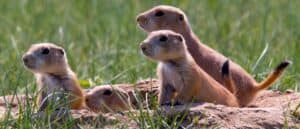One of the best thrills of going to the zoo is seeing the prairie dog exhibit. It’s a fantastic opportunity to go underground and marvel at the elaborate maze network of tunnels these little critters construct as a community.
Did you know that in some states, it is legal to own a prairie dog? This article will highlight everything you need to know about owning these critters, including how to keep them healthy, proper care, nutritional needs, lifespan, and overall costs to keep them in your backyard.
What Are Prairie Dogs?

Black-tailed prairie dogs are easily distinguished by the black tips on their tail.
©Images by Dr. Alan Lipkin/Shutterstock.com
Prairie dogs (genus Cynomys) are ground-dwelling rodents closely related to squirrels. They live in large colonies consisting of around 26 prairie dogs altogether. Prairie dogs are very social creatures, forming families and working together to raise their offspring while protecting the whole colony.
On average, prairie dogs reach 12-16 inches long and weigh 3.5 pounds.
There are five distinct types of prairie dogs living in the North America:
- Black-tailed prairie dogs
- White-tailed prairie dogs
- Utah prairie dogs
- Gunnison prairie dogs
- Mexican prairie dogs
Prairie Dog Lifespan
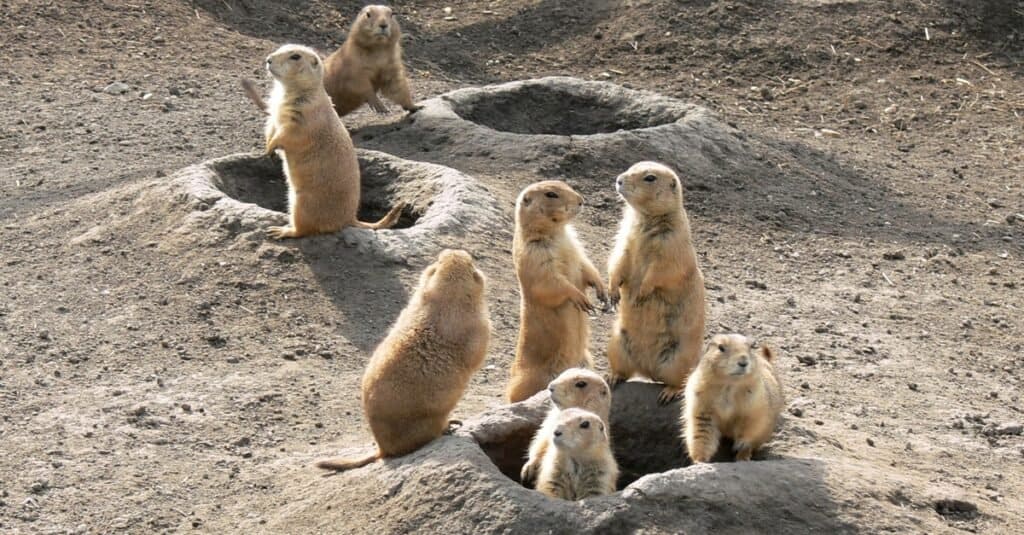
Black-tailed prairie dogs are easily distinguished by the black tips on their tail.
©Zoltan Tarlacz/Shutterstock.com
Rodents typically do not live long lives in the wild. They succumb to predators and diseases transmitted by fleas and many never reach their full lifespan.
- Typically, prairie dogs live three to four years in the wild.
- In captivity, prairie dogs can live eight to ten years.
In the wild, foxes, bobcats, snakes, coyotes, eagles, hawks, badgers, weasels, and ferrets hunt prairie dogs. Diseases such as sylvatic plague transmitted by fleas kill young prairie dogs, reducing the risk of overpopulation.
They have much better lives in captivity because they have no predators to avoid, access to veterinary care, and a constant stream of food and water to maintain their diet.
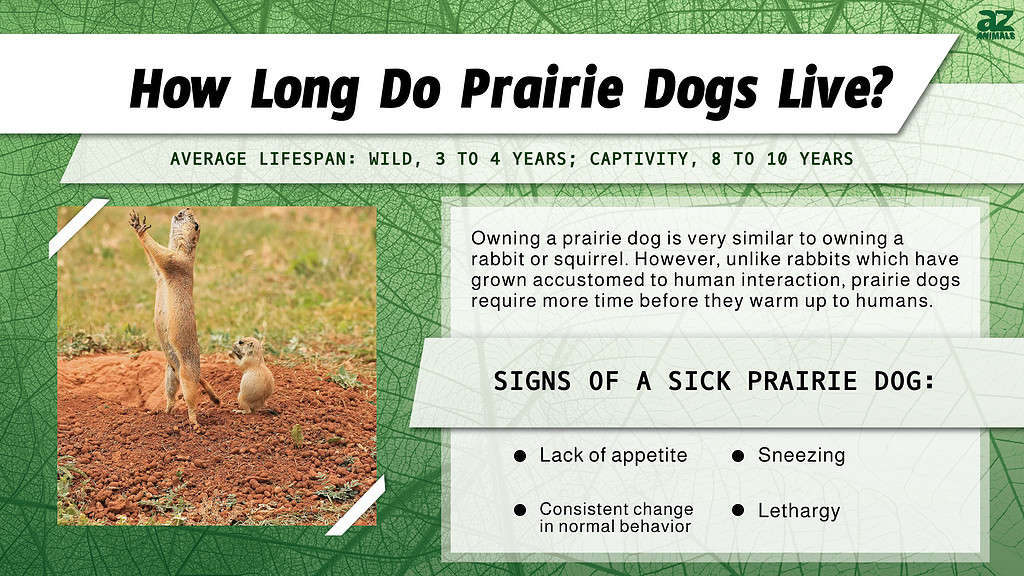
States Allowing Prairie Dogs
Prairie dogs are considered exotic animals in many states of the U.S. Each state has different laws and regulations a prospective owner must know before attempting to purchase an exotic animal. Certain states completely forbid the ownership of exotic animals because in the rare case they escape, they will become an invasive species and cause untold harm to natural wildlife.
Permits and Legal Forms
To purchase an exotic animal like prairie dogs, you must obtain signed permits from the Department of Environmental Protection. These documents certify the animal is allowed to be owned by the individual. You may need to contact other local state departments as well. The owner must have these permits before the purchase.
Some states where prairie dogs are part of the ecosystem do not require permits or legal forms to own. However, owners must purchase from a legal contributor. It is never legal to take a prairie dog from its natural environment.
States Allowing Prairie Dog Ownership without Permit
As of 2023, these are the following states that allow prairie dogs as pets without a permit.
- Alabama
- Arkansas
- Florida
- Kentucky
- Nevada
- Texas
- Washington
- West Virginia
- Wyoming
States Allowing Prairie Dog Ownership with Permit
As of 2012, these are the following states that allow prairie dogs as pets, as long as the owner has all the proper permits.
- Connecticut
- Delaware
- Idaho
- Louisiana
- Maine
- Massachusetts
- Minnesota
- Mississippi
- Nebraska
- New Hampshire
- North Dakota
- Oregon
- Tennessee
- Utah
- Virginia
Where To Purchase a Prairie Dog
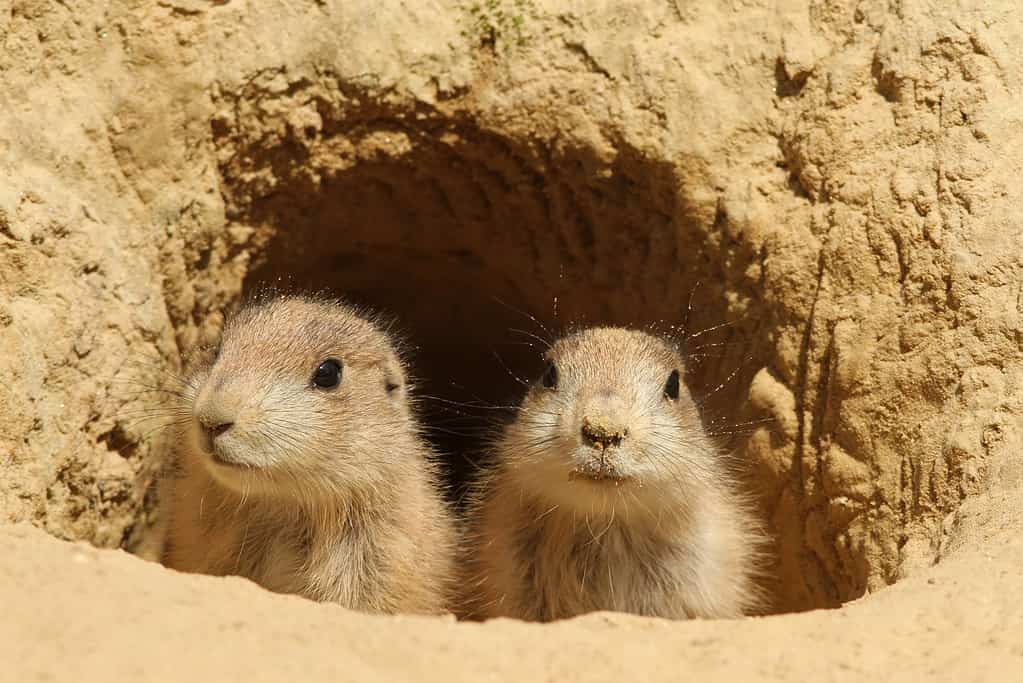
It is illegal to take wild prairie dogs from their natural habitat. Culprits can be fined thousands of dollars.
©Henk Bentlage/iStock via Getty Images
It is illegal to go outside and catch a wild prairie dog to keep as a pet. Local state wildlife and game preservation have laws protecting wildlife from capture without expressed permission to keep the natural habitat unchanged.
On average, a prairie dog can cost approximately $150.
Interested parties have a few options for buying or adopting a prairie dog:
- Exotic Pet Rescue Center
- Animal shelter
- Exotic pet store
- Exotic pet trader
Reputable exotic pet traders and stores will have to provide the permits needed for prairie dog ownership if the state requires them. Permits are inexpensive, typically costing $10-$50.
Larger animals that pose a danger to the pet owner will increase the cost of the license. Some animals like Lynx will have permit costs of $50-$100 to own.
Prairie Dog Care Guide
Owning a prairie dog is very similar to owning a rabbit or squirrel. However, unlike rabbits which have grown accustomed to human interaction, prairie dogs require more time before they warm up to humans. This means pet parents must be patient until their new pet feels comfortable around them. Prairie dogs are naturally very social animals, so it should not take long.
Habitat

Prairie dogs love to explore and interact with their environment. They need plenty of space to run around.
©Wichayasit Suttiwiriyakun/iStock via Getty Images
In the wild, prairie dogs construct elaborate underground tunnels to traverse the grasslands. Within each tunnel is a burrow to pee, poop, sleep, eat, and watch their younglings.
It is possible to keep a prairie dog within the home inside a large stainless steel or plexiglass terrarium. The space needs to be wide enough for them to run around comfortably and deep enough for them to dig burrows. Pet parents can also create a large enclosure for their prairie dog outside within a fenced-in area.
If using an indoor terrarium, use a stainless steel or plexiglass cage. Prairie dogs are natural chewers and will chew anything as a habit. Metal changes can withstand their tiny teeth. Line the space with paper bedding or soil.
If using an outdoor space, provide them with fresh soil that can withstand the elements like rain. The soft soil will closely resemble their natural habitat and make them adjust faster to their new environment.
Litter Pan
Prairie dogs are naturally clean animals. They dig specific burrows within their tunnel network so use the bathroom away from their stored food and young. Place a litter pan with dirt and bedding within the prairie dog habitat to teach them where they should do their business. This will make cleaning their space simpler during routine deep cleaning sessions.
Diet
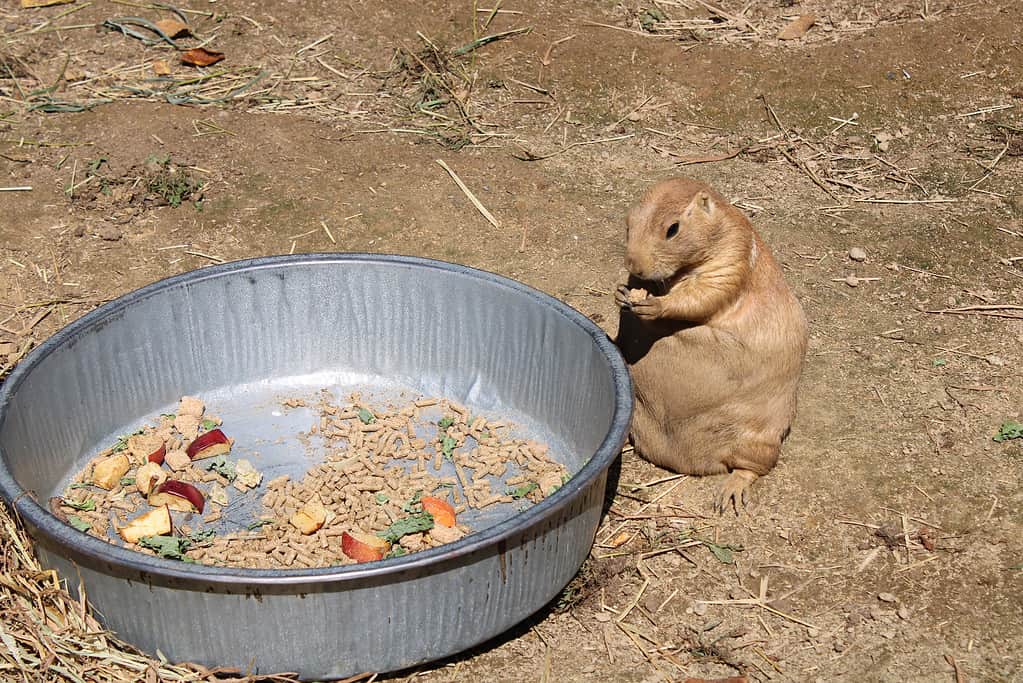
A food bowl of fresh vegetables, hay, seeds, and pellets should always be available for pet prairie dog.
©Jaclyn Vernace/iStock via Getty Images
Prairie dogs are strict herbivores. The majority of their diet consists of leafy greens, seeds, and shrubbery. In the wild, prairie dogs will eat insects for protein, but most of their diet is different types of grasses.
Provide prairie dogs with a diet of whole oats and hay. They love leafy green vegetables like cilantro, kale, Bok choy, and broccoli. Melons and berries are great for extra hydration and a playful treat. However, owners should only give fruits once a week because they are high in sugar, which prairie dogs cannot regulate properly.
A bottle of fresh water should always be available.
Grooming
Prairie dogs are self-cleaning animals. They do not require a traditional bath with soap and water. Instead, prairie dogs perform dirt baths by rolling in fresh dirt to remove any mud and gunk. Providing prairie dogs with fresh dirt is more than enough to keep them clean.
Homeowners have tried to perform small dry baths, wiping down their prairie dog with a damp washcloth to remove any built-up mud. Avoid getting water in the ears, as this can lead to ear infections.
Chew Toys
All rodents are natural chewers. The need to chew is similar to a cat’s need to scratch and claw. Prairie dogs chew to keep their teeth short, mark their space from other prairie dogs, and as a method of playing.
Provide prairie dogs with plenty of strong chew toys to fulfill their natural urges.
Socialization
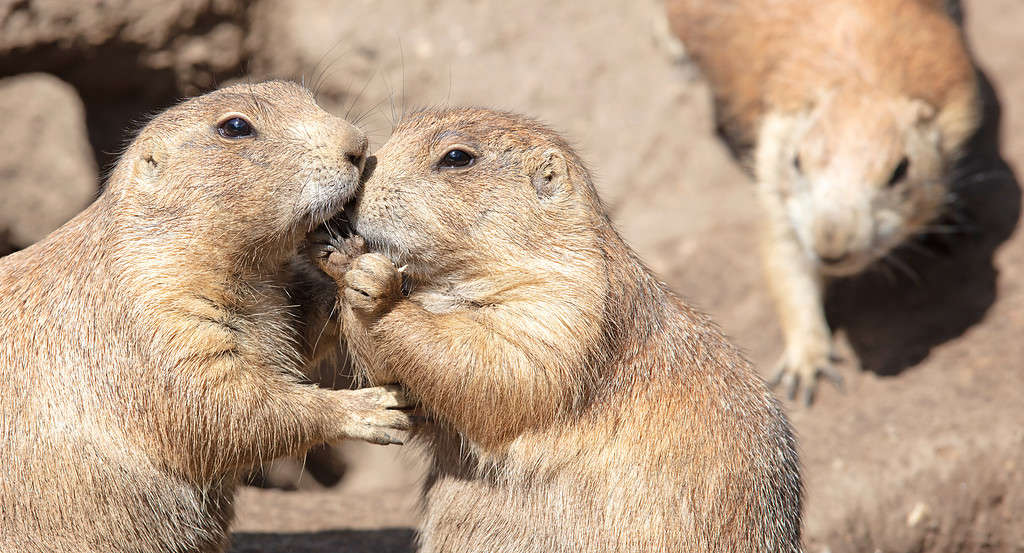
Prairie dogs are very social and affectionate. They give kisses to each other as a form of identification.
©MyImages_Micha/iStock via Getty Images
It will take two to three weeks for a prairie dog to adapt to their unfamiliar environment. Within that time, be gentle and patient as they adjust and feel comfortable. When they are comfortable, then pet parents can start working on socializing and petting them.
Prairie dogs are highly social animals. They will become depressed if left alone for extended periods since they were not meant to be alone. In the wild, they live in large colonies, groom one another, and sleep together for comfort.
Exotic pet suppliers may recommend buying two or three prairie dogs, so the animals have a direct source of comfort when the owner is not home. Certain states like Arkansas allow people to own up to six captive-raised prairie dogs.
Cleaning The Habitat
Outdoor habitats are easier to clean compared to indoor terrariums. Spot-clean the outdoor space by cleaning the litter pan, scooping out old and soiled dirt with fresh dirt, and replacing old chew toys and bedding with new material.
Indoor terrariums should be cleaned every week. Cleaning the litter pan can be done several times throughout the week. Use water and regular soap to clean the side of the terrarium from any dirt, urine stains, or fecal matter. Replenish the old bedding with clean bedding once a week or every two weeks, depending on how dirty the terrarium is.
A consistent and weekly cleaning schedule will keep the tank in better condition and the prairie dogs in a healthier environment.
Medical Care
Exotic shelters and reputable traders will spay and neuter their animals before they are released to the owner. However, this is not a universal rule and prospective buyers should ask before purchasing.
Prairie dogs are aggressive breeders, where mixing male and female prairie dogs will lead to offspring. A female can give birth to three to eight pups in a single litter. Due to disease and predation, only half may survive in the wild. To avoid unwanted offspring, keep same-sex prairie dogs together, or have them spayed and neutered.
Bring prairie dogs to a veterinary clinic twice a year for routine check-ups. Speak with the prairie dog supplier about where to find exotic animal veterinarians in the area as only they know exotic animals.
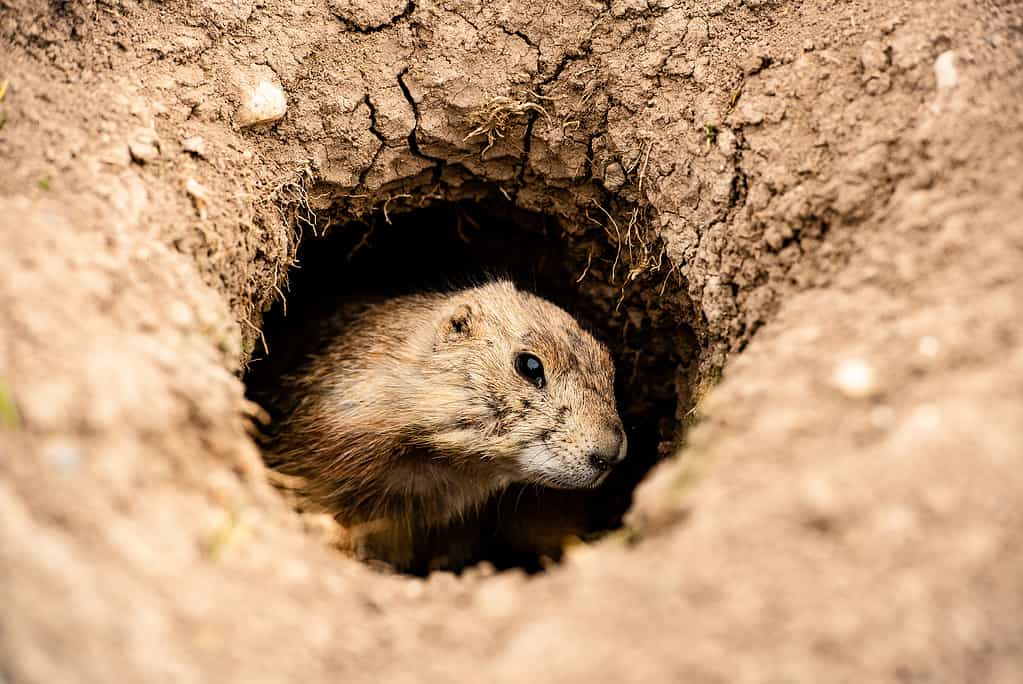
Black marks on pet prairie dogs should be checked by a vet, though these marks in the wild are normal.
©Brandi Lyon Photography/iStock via Getty Images
A healthy prairie dog will be:
- Active and alert
- Eating and drinking normally
- Peeing and pooping daily
- Playful and curious
If a prairie dog exhibits any of the following signs, call an exotic animal veterinarian right away:
- Lack of appetite
- Lethargy
- Coughing
- Sneezing
- Loose stool
- Consistent change in normal behavior
Overall Costs of Owning a Prairie Dog
Prairie dogs are just like any other animal. They require time, attention, care, and a financial commitment to ensure they stay healthy.
Here is a quick financial summary of what it costs to own a prairie dog:
| Item | Quantity / Frequency | Cost |
|---|---|---|
| Prairie Dog | 2-3 | $300-$450 ($150 each) |
| Exotic animal permit | State depending | $10-$20 |
| Food | Weekly | $40 |
| Indoor terrarium | 1 | $200-$400 |
| Outdoor pen or hutch | 1 | $100-200 |
| Bedding/soil | Weekly | $30-$50 |
| Toys | 5-6 | $15-$20 |
| Veterinary Costs | Twice a year | $300+ |
| Total Costs | $900-$1500 |
That initial price point does seem like a lot, but this is very manageable compared to other pets. Veterinary visits will always be expensive, but there are insurance plans to help cover the costs.
Prairie dogs can live eight to 10 years in a carefully monitored and clean environment. They are adorable creatures that will grow fond of their owners over time and will be self-cleaning to minimize any dirt or grime. Check with the local wildlife board to see if prairie dogs are allowed in your area and see if you can take home one of these adorable critters.
The photo featured at the top of this post is © Marie Dirgova/Shutterstock.com
Thank you for reading! Have some feedback for us? Contact the AZ Animals editorial team.




